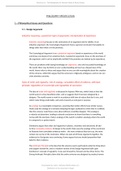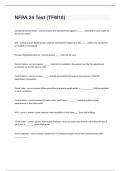PHILOSOPHY SPECIFICATION
1 – Philosophical Issues and Ques
ons
1.1 - Design Argument
Induc
ve reasoning, a posteriori types of arguments, interpreta
on of experience
Induc
ve reasoning focuses on the conclusions of an argument and its validity. As an
induc
ve argument, the Cosmological Argument draws a general conclusion that applies to
things other than what is in the premises.
The Cosmological Argument is an a posteriori argument based on experience of the world
and draws conclusions from empirical facts. A posteriori arguments focus on the premises of
the argument, and it can be empirically veri+ed if the premises are backed up by experience.
There are problems with basing knowledge on experience: one only has par
al knowledge of
the world, there may be limits on one's understanding and one has a biased view of the
world. Hume refers to these and argues that no one can talk meaningfully about the crea
on
of the universe, while Hick argues that the universe is religiously ambiguous, and no one can
claim absolute certainty.
Types of order and regularity, role of analogy, cumula
ve e/ect of evidence, anthropic
principle, regulari
es of co-principle and regulari
es of succession
The idea of order and regularity is discussed in Aquinas' +2h way, which looks at how the
world seems to show bene+cial order, and so suggests that it has been designed by a
designer. The world seems to work in accordance with laws of nature that don't vary, and
which make things predictable, and works towards an end goal or purpose.
An analogy is a meaningful comparison, assuming that similar e/ects have similar causes.
Hoyle used the analogy of a tornado sweeping through a junkyard to show that it is unlikely
that the universe could have come about without a God-like designer. This analogy is
a reduc
o ad absurdum, leading to absurd conclusions to show that there is something
wrong with the premises. Paley's analogy of the watch is another anaology where the world
in compared to a pocket watch.
Swinburne argues that order and regularity in physics, chemistry and astronomy all add
to thre cumula
ve evidence of design in the world. Paley uses the analogy of the courtroom
to illustrate how cumula
ve evidence works – the more evidence that turns up, the more
certain one can be of the conclusion. When one puts all of these arguments together, the
evidence for God grows very convincing. Hume argues that one should propor
on their
belief to their evidence.
The Anthropic Principle is the idea that the universe seems par
cularly suited to bring about
and support human life, and is a modern version of the Design Argument built upon
Swinburne's concept of regularity. It was put forward by Tennant and has three forms. The
Strong Anthropic Principle claims that the en
re universe was designed to produce human
Downloaded by: bebro |
Distribution of this document is illegal
, Stuvia.co.uk - The Marketplace for Revision Notes & Study Guides
life, supported by the goldilocks enigma. The Aesthe
c Principle points to the ability humans
have to perceive beauty, however there is no reason for the universe to be beau
ful or for
humans to be able to appreciate it, sugges
ng that the designer arranged this. The Weak
Anthropic Principle claims that the universe was designed not for humans speci+cally, but for
creatures like them.
Swiburne suggests that there are two types of regularity in the universe: regulari
es of co-
principle and regulari
es of succession. Regulari
es of co-principle refers to the tendency for
things to turn up together in orderly pa8erns (spacial order). Regulari
es of succession refers
to orderly processes that operate the same way every
me, like the laws of nature, which
point towards +ne-tuning and the Anthropic Principle
Strengths and weaknesses of Design Arguments: probability rather than proof, alterna
ve
interpreta
ons, including evolu
on and deism, challenges to the argument
The Design Argument is an a posteriori argument that uses induc
ve reasoning, meaning
that it leads to probable conclusions rather than proof. Hume claims that there is a problem
of induc
on which means that one has no ra
onal basis for expec
ng the future to resemble
the past. Though the argument for cumula
ve evidence suggests that the argument should
be accepted as more probable than not, religious believers usually want to demonstrate
God’s certainty, not his probability, of exis
ng.
Alterna
ve interpreta
ons of design can be reached, such as evolu
on and deism. Darwin’s
theory of evolu
on proposes that simple life forms evolve into complexity over
me,
explaining the appearance of design without the need for a designer. Behe argues the term
irreducible complexity to refer to organisms that couldn’t have evolved from something
simpler to prove the existence of a designer. Occam’s Razor advises one to choose the
simplest answer, which is evolu
on. The design argument shows the existence of a designer,
but not necessarily the God of monotheism, and it could be that the deist God is the
designer. This is a non-interven
onalist God who creates the universe, but then has nothing
more to do with it.
Hume and Dawkins challenge the design argument and argue that the designer himself
would need a designer, and so would he, as in+nitum. However, Aquinas combats this with
the idea of divine simplicity – that God is supremely simple, and so does not require a
designer. Occam’s Razor argues that the simplest answer is the best. The Design Argument
brings in something else that needs explaining – an all-powerful designer God – in the face of
something which needs explaining, which mul
plies en
es unnecessarily and goes against
Occam’s Razor. Religious believers argue that God is simple and without component parts,
however Dawkins proposes that God must be at least as complex as the universe he is
supposed to have designed. Haeckel rejected the Design Argument and instead developed
the Dysteleological Argument, poin
ng out the instances of imperfec
on and lack of purpose
in the universe which suggest its designer must be incompetent or evil. This is supported by
the problem of evil and su/ering, and Mill points out that the evil far outweighs the good,
and thus the creator must be immoral.
Philosophical language and thought through signi+cant concepts and the works of Paley and
Hume
Downloaded by: bebro |
Distribution of this document is illegal











